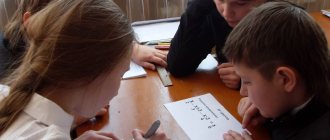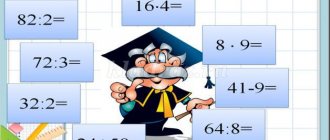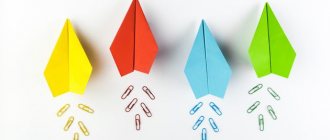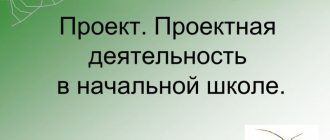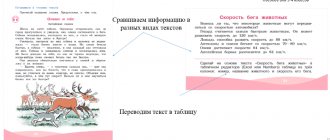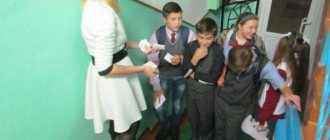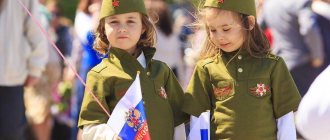The essence of the concept of “activity”
Activities in the literature of a psychological and pedagogical orientation are determined by a specific type of manifestation of a person’s initiative, which presupposes knowledge, creative understanding of the world around and understanding of oneself in this world.
The Federal State Educational Standard (FSES) defines five vectors of the educational process (cognitive development, speech development, social and communicative development, physical, artistic and aesthetic), which are implemented by combinations of forms of activities practiced in a preschool educational institution (DOU), fulfilling a specific mission in depending on the age of the pupils.
Children are involved in different types of activities through a whole range of forms of interaction.
Table: types of activities and forms of interaction with children in preschool educational institutions
| Kind of activity | The essence | Forms of working with children |
| Gaming | The main type of activity of preschoolers, aimed at the work process and characterized by the fact that the child accepts a conditional situation. | Creative games (theatrical):
|
Games with set conditions:
| ||
| Research-cognitive (intellectual-cognitive) | A type of activity for children that promotes the establishment of connections between phenomena and objects of the surrounding world, as well as the development of cognitive techniques. |
|
| Communicative | A type of activity aimed at establishing contact with other people through communication in any oral form. | |
| Fine | An activity that involves the creation of a material product of creative understanding of reality. |
|
| Self-care and household work activities | Directed efforts designed to realize ideas about ways to satisfy physiological and moral needs. |
|
| Construction | An activity that forms the child’s spatial thinking and the ability to predict the final result of the activity. | Construction from:
You can get acquainted with the theoretical foundations of organizing a design lesson here. Interesting types of work can be found in the index of construction games. |
| Musical | A type of activity that gives the child the opportunity to be in the position of a creator, performer or listener. |
|
| Perception of literature and folklore | A type of work that does not imply passivity, but the activity of studying the plot, that is, creating the effect of presence. |
|
| Motor | Helps children realize motor function and thereby solve motor problems. |
|
This is interesting. The mission of organizing activity for preschool children is the same for children of all groups; the differences lie only in the tasks that are set for children of one or another age.
Table: goals and objectives of activities by age groups
| Kind of activity | Goals | Tasks |
| Gaming |
| First junior group:
|
Second junior group:
| ||
Middle group:
| ||
Senior group:
| ||
Preparatory group:
| ||
| Research and educational |
| In the younger groups, these tasks will be unified, since the work in the second continues the directions that were started in the first:
|
In the middle group:
| ||
In the senior group:
| ||
In the preparatory group:
| ||
| Communicative |
| In the first junior group:
|
In the second youngest:
| ||
In the middle group:
| ||
In the senior group:
| ||
In the preparatory group:
| ||
| Fine |
| In the first junior group:
|
In the second youngest:
| ||
In the middle group:
| ||
In older groups:
| ||
| Self-care and household work activities |
| In the first junior group:
|
In the second youngest:
| ||
In the middle group:
| ||
In older preschool age:
In the preparatory group, shoe care is added, which the kids wash, wipe, and clean with cream after appropriate weather. | ||
| Construction |
| In younger groups:
|
In the middle group:
| ||
In older preschool age:
| ||
| Musical |
| Musical activities pose the following tasks for preschool students, regardless of age:
|
| Perception of literature and folklore |
| The tasks of this type of activity will also be generalized, the only difference is in the material with which the kids work. For example, in the younger groups these are fairy tales (“Turnip”, “Teremok”, etc.), in the middle and older groups these are texts in which there are more heroes and plot twists. So, the tasks of implementing this type of activity are:
|
| Motor |
| In younger groups:
|
In the middle group:
| ||
In the senior group:
| ||
In the preparatory group:
|
Video: gaming activity as a mechanism for the development of a preschooler - webinar by the coordinator of the preschool education direction of the educational system "School 2100"
You can learn about the educational program “Kindergarten 2100” from our article - Program “Kindergarten 2100”: an educational process without stress and overload.
The importance of extracurricular activities at school according to the Federal State Educational Standard
The federal state educational standard for primary general education provides for the implementation of the basic educational program of primary general education through classroom and extracurricular activities. One of the models for organizing extracurricular activities of students is the work of the GPD, holding extracurricular events, holidays, subject weeks and olympiads.
Extracurricular activities are organized in the areas of personal development (sports and recreational, spiritual and moral, social, general intellectual, general cultural). For children attending the GPD, this activity can manifest itself in such forms as excursions, clubs, sections, debates, competitions, search and scientific research, socially useful practices, etc.
Spiritual and moral development involves introducing schoolchildren to the cultural values of their ethnic or sociocultural group, the basic national values of Russian society, and universal values in the context of the formation of civic identity. The teacher creates a system of educational activities that allow the younger student to master and put into practice the acquired knowledge. At the same time, historical, cultural, ethnic and regional specifics are taken into account and conditions are created for the formation of an active position in children.
Planned results of spiritual and moral education:
• formation of value orientations, social competencies, behavior patterns of younger schoolchildren;
• broadening one's horizons, developing a common culture;
• familiarization with the universal human values of world culture, the spiritual values of national culture, the moral and ethical values of the multinational people of Russia and the peoples of other countries;
• formation in children of value orientations of universal human content, an active life position, the need for self-realization in educational and other creative activities;
• development of communication skills, self-organization skills;
• formation and expansion of experience of positive interaction with the outside world, education of the foundations of legal, aesthetic, physical and environmental culture.
The formation of a culture of a healthy and safe lifestyle is carried out through a comprehensive program for the formation of knowledge, attitudes, personal guidelines and norms of behavior that ensure the preservation and strengthening of the physical, psychological and social health of pupils as one of the value components that contribute to the cognitive and emotional development of the child, the achievement of planned development results basic educational program of primary general education.
The goals of this direction:
• ensure the awakening in children of a desire to take care of their health (formation of an interested attitude towards their own health);
• formulate attitudes towards the use of a healthy diet;
• create conditions for the use of optimal motor modes for children, taking into account their age, psychological and other characteristics;
• develop the need for physical education and sports;
• maintain a daily routine;
• develop knowledge of negative risk factors for children's health (reduced physical activity, smoking, alcohol, drugs and other psychoactive substances, infectious diseases);
• promote the development of skills to resist involvement in smoking, drinking alcohol, narcotic and potent substances;
• develop the child’s needs to fearlessly consult a doctor on any questions related to the characteristics of growth and development, health status, development of readiness to independently maintain their health based on the use of personal hygiene skills.
In order to ensure the implementation of the basic educational program of primary general education in an educational institution, conditions must be created for students to ensure the opportunity to:
• identifying and developing the abilities of students through a system of clubs, sections, studios and circles, organizing socially useful activities, including social practice, using the capabilities of educational institutions for additional education of children;
• working with gifted children, organizing intellectual and creative competitions, scientific and technical creativity and design and research activities;
• participation of pupils, their parents (legal representatives) in the development of the basic educational program of primary general education in the sections “Program of spiritual and moral education and development of children of primary school age” and “Program for the formation of a culture of healthy and safe lifestyle”, as well as in the formation and implementation of individual educational routes for students;
• use of modern activity-type technologies in the educational process.
The organization of the work of extended day groups must strictly comply with basic regulatory documents.
Regulatory framework for organizing extracurricular activities at school
• Law of the Russian Federation dated July 10, 1992 No. 3266-1 “On Education” (as amended and supplemented).
• Order of the Ministry of Education and Science of the Russian Federation dated October 6, 2009 No. 373 “On approval and implementation of the Federal State Educational Standard for Primary General Education” (registered by the Ministry of Justice of the Russian Federation on December 22, 2009 No. 15785).
• Resolution of the Chief State Sanitary Doctor of the Russian Federation dated July 23, 2008 No. 45 “On approval of SanPiN 2.4.5.2409-08” (together with the Sanitary and Epidemiological Rules and Standards “Sanitary and Epidemiological Requirements for the Organization of Nutrition for Students in General Educational Institutions, Primary and Secondary Vocational Institutions education. SanPiN 2.4.5.2409-08"),
• Decree of the Government of the Russian Federation dated 03/07/1995 No. 233 (as amended on 03/10/2009) “On approval of the Model Regulations on the educational institution of additional education for children.”
• Decree of the Government of the Russian Federation of March 19, 2001 No. 196 (as amended on March 10, 2009) “On approval of the Model Regulations on a General Educational Institution.”
• Letter of the Ministry of Education of Russia dated September 25, 2000 No. 2021/11 -13 “On the organization of education in the first grade of a four-year elementary school.”
• Methodological recommendations “Organization and mode of operation of an extended day group”, approved by the Main Sanitary and Epidemiological Directorate of the USSR Ministry of Health dated December 12, 1979 No. 2111-79.
We recommend watching:
Organization of activities of an after-school group
Goals and objectives of the after-school group
Walks and their types in extended day group mode (DG)
Job description of a GPA teacher
Calendar and thematic planning of the GAP
How to motivate children to do different activities
Setting up a child for one type of activity or another, switching from another activity, is a difficult task that a teacher faces several times a day. And in this sense, the methodological baggage of techniques that simplify this very transition acquires special significance. It should be said that the methodology does not have a strict framework regarding which technique motivates which type of activity. It all depends on the appropriateness of using each of them: relevance to the topic, effectiveness in relation to a specific group of children, as well as the content of the material of this technique.
The choice of motivational techniques also depends on the individual characteristics of children in a particular group.
Table: motivational techniques for different types of activities in kindergarten
| Reception | What type of activity motivates | Example |
| Conversation |
| Can be used to motivate activities on any topic. Conversation files for:
|
| Puzzles |
| A universal technique that has great methodological potential and does not require much time. You can start a music lesson with middle school children, where the children are expected to play instruments, with the following riddles:
|
| Poems |
| For those on duty who, as part of unregulated activities, begin duty, the following lines will be motivating:
|
| Fairy tales |
| At a design lesson, before making frames from newspaper tubes, I tell my senior group students a story about a miraculous transformation. “Once upon a time there was one newspaper in the world. It was very interesting, so all family members read and re-read it. But the newspaper has aged and become uninteresting. One day she lay down on the windowsill, where she began to think about what would happen to her next. These thoughts were very sad, since several times she saw the owner throwing old newspapers into the trash can. And suddenly the Paper Fairy flew in. She felt sorry for the Newspaper, and the sorceress turned her into a beautiful rose, which began to decorate the windowsill. |
| Reading |
| In the preparatory group, before playing lotto by type of fish, the children of the preparatory group themselves read out short information about the amazing features of the inhabitants of the depths. |
| Looking at pictures |
| So, before making a house for a toy from a Lego constructor, children in the older group carefully examine the assembly diagram. |
| Watching a video (multimedia presentation) |
perception of literature and folklore. | A discussion on the content and main idea of the fairy tale “Porridge from an Ax” in an older group can begin by watching a cartoon. |
| A game | All | In the second younger group, before starting to construct a “dog house,” the teacher invites the kids to play the didactic board game “Help the baby find its mother,” in which the children connect two parts of the picture: an adult and a baby. To make it more difficult, you can ask children to classify animals into two categories: domestic and wild. |
Video: illustrative material for viewing - cartoon “Porridge from an Axe”
Extracurricular activities in elementary school
Organization of extracurricular activities in primary school
“...there are wonderful, brilliant lessons there,
where there is something else wonderful, besides lessons,
where a wide variety of
forms of student development outside of class«
V.A. Sukhomlinsky
The children's team is the condition, means and place for the formation of the personality of each child. Therefore, attention to the issues of organizing extracurricular activities and the formation of a children's team should be constant and unrelenting throughout all the years of children's education in primary school.
The process of forming a class team occurs in various types of activities: educational, gaming, labor. The class team is the main one in the life of a primary school student, because it is there that activities are socially valuable and significant for children. In the classroom group, children carry out the leading activity - learning, which is the main factor in their general and moral development. A child can also be in other groups, where he develops and improves his most diverse abilities. However, interest groups, such as clubs and sections of out-of-school institutions, music and art schools, and sports schools, play rather a supporting role in the development of a child’s personality.
A child’s personality is diverse and is not limited to academic success and discipline. Each student has his own interests and needs, moral qualities, character traits and abilities for one or another type of activity. All this can and should find the necessary conditions for positive development in extracurricular work with younger schoolchildren.
The pronounced imitation of children, the limitedness of their life experience, insufficiently developed independence, the inability to critically comprehend their behavior and the behavior of their comrades - this is not a complete list of age-related characteristics and the difficulties that a teacher encounters in working with a group of primary schoolchildren in the process of comprehensive development of individuality every child in extracurricular activities.
In the 1st grade, teachers begin working with a not yet organized group of children, which in the future will become a friendly and united children's team; it should become the main one in the development of the child; everything that the child receives in other groups should be realized in the classroom team. A children's team usually does not develop until each child determines for himself what forms of behavior and what kind of attitude can be expected from any member of the team. The process of mutual recognition occurs both in joint activities organized by the teacher during lessons, on excursions, at club classes, competitions, tournaments, relay races, in joint trips to the theater, cinema, circus, library, in the process of preparing homework, and in the process of communication children at recess, on the street, in the yard.
Five stages of development of any type of activity in a child
Regardless of the type of activity, children go through five stages of its development. Let us dwell on each, using as an example the mastery of modeling by children of the first and second junior groups as an element of visual activity:
- independent or free activity of the child (kids of the first junior group try to crush plasticine, warm it in their hands, increasing the plasticity of the material);
- difficulties (children cannot give the desired shape to plasticine);
- activity together with an adult (the teacher shows how to tear off a piece of plasticine, roll it between your palms, giving it the shape of a ball, and then, if necessary, flatten this “ball” to make a “pancake”);
- activities next to or together with friends (I gave my pupils in the second junior group the task of using “pancakes” to pave the path of the Kolobok “ball” from a cardboard house to a paper forest, where each kid lays his part of the “pancake” path);
- amateur activities (for example, my kids made a “family of balls” and used them to act out the plot of a fairy tale - invented, seen in a cartoon, or based on the well-known fairy tale “Turnip”).
Each level of mastering an activity is, of course, important, but the “turning point”, that is, providing the possibility of further evolution of a particular type of activity, is the stage of joint work with an adult. At this stage of mastering activities, children enrich their personal experience and also realize the mistakes of the difficulty stage. As a result, they successfully move to the level of activity next to or together with friends and amateur activities. Thus, the third level of activity development requires special methodological precision in development.
Any activity goes through five stages of development
Table: Melnikova O.I., summary of joint educational activity with children of the middle group within the framework of the topic “My friend the robot” of educational and research activities (fragments)
| Lesson stage | Contents of the stage |
| Organizational search or introductory | Greetings |
| - Guys, please come to me: one, two, three, four, five - I want to invite you to play with me. And you want to play a very interesting game with me, but only our game has one main rule: if I ask you questions during the game, you will answer them with a complete answer. Anya, repeat, what is the rule in our game? Educator: - Guys, are we going to accept the rules of the game and answer questions with complete answers? Educator: - Then, guys, one, two, three, four, five, it’s time for us to start the game. I brought you something interesting. Look, what is this? Don’t forget about the rule: we answer with a complete answer. Educator: - That's right - it's a bag. Do you want to know what's inside? How do we know what's inside? /various answers from the children, children offer various options for examining the object in the bag/ Educator: - Bogdan, carefully touch the bag with your fingers, guess what’s inside? Educator: - Okay, Bogdan thinks that there are cubes or boxes inside. Guys, how else can we find out what’s inside the bag? Polina, what do you think? Don’t forget about the rule: we answer with a complete answer. Educator: - You think that we need to look inside. Let's take a look, one, two, three, look. What are these guys? Educator: - That's right - these are boxes. I suggest you pick up one box you like and stand in a big circle. Guys, let's look at our boxes, but we won't just look at them, we'll play with them. This game is for attention and you all need to be what? Educator: - Correctly attentive. Don’t forget about the rule: we answer with a complete answer. | |
| Basic | Didactic game “What’s in the box” Educator: - Tell me, what are our boxes made of? Educator: - That's right, from paper. Arseny, show the guys your box. Guys, tell me, what kind of box does Arseny have? Educator: - You are so attentive, that’s right, it’s big and red. Guys, pay attention, now lift up the boxes, those guys whose boxes are similar to Arseny’s boxes, the same color and size. Okay, Roma, check if everyone picked up the cubes correctly? Educator: - Arina, show the guys your box. Guys, tell me, what kind of box does Arina have? Don’t forget about the rule: we answer with a complete answer. Educator: - That's right, she's average, white. Attention, guys, now shake those boxes over your heads, those guys whose boxes look like Arina’s box. Okay...> |
| <… Educator: Kolya, how would you like to play with our boxes? Educator: - Guys, Kolya wants to build a tower out of them. How would you, Roma, play with the boxes? Educator: - Roma would build a house. Fine. Yes, but we play all these games every day. Educator: - And I know that a new toy has appeared in our play corner. Come on, come on, guys, who guessed which one? Don’t forget about the rule: we answer with a complete answer. Educator: - That's right, it's a robot. How many of you like to play with robots? Stand on your toes and raise your hands high, high? Everyone loves playing with robots, it's so cool. Guys, let's look at our new friend and list what our robot has...> | |
| Educator: - Can you and I make the same robot? What can you and I make it from? Educator: - That's right, from colored paper boxes. Do you want to have a friend like this at home with whom you can play? Educator: - How are we going to collect it? We definitely need to make a plan for how we will assemble the robot. Bogdan, what will we do first, what box will we take, name it and show it. Educator: - You suggest taking a big red box, what do you think we can make from this box. Educator: - Guys, look correctly from this box, you can make a torso...> | |
| <... Educator: - Guys, now each of you will try to assemble a robot. It turns out? No? And why? Educator: Correct! All parts of the robot need to be glued. And this is what you will do now. And if any of you forget which box needs to be glued, then we will help you with our hint diagram, which we compiled together and posted on the board /children’s independent work/...> | |
| <... Educator: - Guys, it seems to me that your robots are missing something? What? Look carefully at our guest and at your friends. What is missing? Educator: - That's right, face, mouth, nose and eyes. And what will we make them from, because we have nothing else left. Of course you can draw it. Let's draw. | |
| Educator: - Look what a wonderful friend each of you has made. After all, having many friends is so great! Guys, we collected, decorated, drew a face, what's missing? Guys, tell me how we will contact our robot. What do we need to do? Don’t forget about the rule: we answer with a complete answer. Educator: - Come up with the right name. Vova, I know you love robots very much, what will you call your new friend? Educator: - I like Robik. Guys, we know each other, I know? what is your name, your name is Masha. Masha, what is the name of your robot friend...> | |
| Reflexive-corrective or final | <... Educator: - How beautifully you all danced with your robot friends just now. Guys, tell me, did we manage to find new friends during our game? Raise your friends high and high and show them to our guests. Guys, why were you and I able to make robot friends? Daryana, whose robot friend did you like during the dance, who, in your opinion, danced better. Vova, has your robot friend already found a robot friend in our group? Guys, tell me, what’s your mood now? I really liked the way you all worked today. Guys, what will you tell your moms and dads at home this evening? / Various answers from children. Educator: - And now we all need to put in order the place where you and I worked /children clean their workplace/. |
Extracurricular activities of a social orientation in preschool educational institutions of the Ministry of Defense of the Russian Federation: features of organization and implementation
The educational system of the VU assumes that students stay within its walls around the clock (often such a system is called a boarding school); accordingly, it is also expected that the extracurricular time of Suvorov students will be filled with activities of a developmental, educational and socializing nature.
If we turn to the daily routine of senior students (studying according to the standards of the previous generation), we will see that it provides time for extracurricular activities, which are held according to a separate schedule.
This time is filled with “educational work” activities, is present in all courses and involves the implementation of education in relevant areas. The blocks “mass sports work” and “labor education” are highlighted separately. During this time, relevant activities are implemented.
Consequently, in its essence, extracurricular activities (including social ones) are not something foreign for the Suvorov School (unlike schools, where the introduction of extracurricular activities in accordance with the second generation Federal State Educational Standard, among other things, requires a complete restructuring of the functioning mode ).
What is new for us in the second generation Federal State Educational Standard in the context of extracurricular activities?
We can give an answer to this question only partially and only now, when the first experience of implementing extracurricular activities in VCU according to the second generation Federal State Educational Standard has appeared.
According to the second generation standard, extracurricular activities are one of the forms of organizing extracurricular time aimed at developing the personality of students. It presupposes clear planning by school teachers, achieving specific results in mastering the basic general education program, i.e., in fact, it becomes part of it.
The social direction of extracurricular activities is designated as one of the mandatory ones (along with sports and recreational, spiritual and moral, general intellectual, general cultural).
The peculiarity of extracurricular activities with a social orientation in VCU is that the types of activities recommended for the social orientation are already an integral component of its educational process.
For example, socially useful labor, proposed by methodological manuals as one of the foundations, is an integral part of the educational process of the educational process; this is its traditional component (PCB, self-service, cleaning of urban necropolises, etc.). The military-patriotic and related sports basis is the leitmotif of the entire educational system of the SVU.
That is why we highlight the socialization of students as the foundation of the social direction (here the conditions are dictated by the characteristics of a boarding-type educational institution).
We are close to the understanding of the essence of the socialization process as a dialectical unity of adaptation processes (as a person’s entry into the social environment and its adaptation to cultural, psychological and sociological factors) and a person’s self-realization of his potentials and creative abilities (as overcoming the negative influences of the environment that interfere with his self-development and self-affirmation) [2, p. 140].
Since Suvorov students are future defenders of the Fatherland, citizens who accept the fate of Russia as their own, it is important for us to develop in them good adaptation skills and qualities, as well as skills and qualities that allow them to overcome the negative influence of the environment, conduct effective transformative activities in a changing society, implement your creative abilities, etc.
Thus, we define the goal of activity within the framework of the social direction at the USSVU as the creation of conditions for the student’s transition to the position of an adaptive and active member of civil society, capable of self-determination on the basis of basic values, developing their own understanding, developing and implementing projects for transforming society [3].
A detailed examination shows that the social direction was present in the activities of educators, teacher-organizers and educational psychologists earlier (in civil-patriotic, spiritual-moral, military education and military-vocational guidance, etc.). The educational activities of these specialists inherently involved the socialization of students, but it was not clearly coordinated for all specialists. The activities of teacher-organizers and educational psychologists with Suvorov groups were planned according to the residual principle “in their free time.” Thus, if previously time was allocated for educational work in general, now - for the implementation of specific programs, including social ones.
Extracurricular activities with a social orientation are a priority for educators, educational psychologists and teacher-organizers. This is due to the job responsibilities of these categories of teachers. Although not only they are now involved in the planned process of development, education and socialization of students. Subject teachers and additional education teachers (for example, general cultural, sports and recreational areas) are involved on completely legal grounds. All these categories of teachers work, in essence, for the result that is laid down in the program of basic general education.
The senior educator, educators of training platoons, teacher-organizer and educational psychologist of the company are teachers of one unit; they have the opportunity (unlike schools) and must set a single, general goal of education and socialization for the entire course. For this purpose, they develop targeted aspects of their work programs, and also coordinate activities depending on the characteristics of the Suvorov team of the company, platoon and the individual characteristics of the children.
Organizationally, within the framework of extracurricular activities of VCU, the spiritual, moral and sports and recreational areas are most closely connected with the social direction (although, as mentioned earlier, all areas of extracurricular activities work for development, education and socialization). It is these areas that are predominant in the activities of course teachers.
At the same time, the teacher-organizer develops his own work program, the teacher-psychologist develops his own, educators implement the education and socialization program, plus, as part of mass sports work, they implement the activities of the sports and recreation program. Teachers have the opportunity to agree in advance on the ratio of activities by focus between company teachers, as well as the proportion of activities in one direction or another.
Another specific feature of the organization of extracurricular activities with a social orientation at the UGSVU is its mandatory nature. If, within the framework of general cultural and general intellectual areas, students have the opportunity to choose circles, clubs, etc., then attending extracurricular events of a social, sports, recreational, and spiritual-moral nature is mandatory for all Suvorov students. This is where the traditional nature and military orientation of the educational process in IEDs comes into play.
The implementation of extracurricular activities at the stage of basic general education (including social) presupposes its continuity with primary general education. It is not possible to ensure this continuity at the school, since Suvorov students enter the USVU after graduating from primary school from various regions of Russia. Taking this feature into account, social programs for the fifth grade are focused on the rapid adaptation of students to the conditions of the State Educational Institution.
And then, when during the first year of study the course teachers have sufficiently studied the personal characteristics of these students, it is possible to build a successive course of extracurricular activity programs only for subsequent years of study.
As part of extracurricular activities for the socialization of students, the following results are planned:
First level results:
− acquisition of social knowledge (about social norms, the structure of society, socially approved and disapproved forms of behavior in society, etc.), a primary understanding of social reality and everyday life.
Second level results:
− students gain experience and a positive attitude towards the basic values of society (person, family, Fatherland, nature, peace, knowledge, work, culture), a value-based attitude towards social reality as a whole.
Third level results:
− gaining experience in independent social action [1].
These results are included in the education and socialization program, are reflected in work programs with a social orientation and are implemented during various events. However, when developing programs, choosing forms and means of achieving goals, certain questions arise. The regulation of the educational process of the educational process and the special organization of students’ life activities significantly complicate the implementation of the forms and types of extracurricular activities necessary to achieve third-level results, since they presuppose a fairly wide range of external social connections and free interaction of students with an open society.
Thus, despite the fact that education has always been an integral part of the educational process of the High School, was implemented in a specially designated time and had a certain focus, now, in the context of the implementation of the second generation Federal State Educational Standard, it is being transformed and acquiring new features. The normatively established emphasis on the active socialization of students requires the search for new forms and methods of implementing now all extracurricular activities. The personnel and time resources embedded in the system for constructing the educational process of the VU allow us to solve the tasks assigned to the teaching staff. However, modern trends require the teaching staff of VU to get rid of stereotypes while maintaining traditions, creative search and constant improvement of professional level.
Literature:
- Skvortsova O. V. Organization of extracurricular activities of students for the implementation of the Federal State Educational Standard LLC // Social network of education workers “Our Network”. URL: https://nsportal.ru/shkola/administrirovanie-shkoly/library/2015/08/24/organizatsiya-vneurochnoy-deyatelnosti (date of access: 04/1/2016).
- Slastenin V. A. et al. Pedagogy: Textbook. aid for students higher ped. textbook establishments. - M.: Academy, 2002. - 576 p.
- Methodological recommendations “Organization of extracurricular activities for junior schoolchildren” // Infourok. URL: https://infourok.ru/-37876.html (access date: 03/30/2016).
Unregulated and extracurricular activities in preschool educational institutions
The educational process in kindergarten is a combination of direct educational, regulated activities (DEA), that is, classes, and unregulated activity - activity based on voluntary principles and carried out outside of GED: when performing routine moments, during organization and participation in leisure activities , in the work of circles and sections.
Unregulated activities are carried out outside the GCD
Table: types and forms of unregulated activities
| Communication | A game | Cognitive practical | Artistic | Elementary labor |
|
|
|
|
|
This is interesting. Extracurricular activities of preschool children in the methodological literature are often used as a synonym for unregulated. However, there is one important nuance in this combination of terms: when we talk about extracurricular activities, we usually mean the work of clubs and sections, but the concept of unregulated activity of children includes all (!) types of interaction, with the exception of non-curricular activity (activities). That is, it turns out that when they talk about extracurricular activities, they rather mean the form of organizing work with children, and when they talk about unregulated activities, they mean specific ways of interacting with students.
Leisure is one of the most favorite formats of unregulated activity for children
The educational process in kindergarten is based on a combination of different types of activities of preschool children in one form or another. For the most effective implementation of educational tasks, the teacher needs to methodically combine these forms and types using suitable motivational techniques. Then preschoolers will have a comprehensive knowledge of the world around them, which is the key to the formation of a harmonious personality of each child.
Primary School Extracurricular Activities Plan
As part of the implementation of the Federal State Educational Standard, the curriculum of the 1st, 2nd and 3rd grades includes extracurricular activities in the amount of 6 hours (3 hours - PDO, 2 hours at the expense of the GPD and 1 hour at the expense of the psychology rate). A team of teachers developed original programs of extracurricular activities, which were approved at a meeting of the school’s teachers’ council and some of them were reviewed by SKIPKRO. The main regulatory legal document defining extracurricular activities is the federal state educational standard.
During the experiment, a new type of educational institution was created on the basis of the school, where all conditions are provided for the comprehensive development of the individual and the individualization of the learning process; Extracurricular activities have been developed, a system of additional education has been organized, student self-government is in place, work is being done to protect health, while the relationship between the school and the family, extra-curricular institutions, and society has strengthened.
Junior school age is the most favorable period in the development of personality. It is at this time that the child becomes aware of the relationship between himself and the world around him, masters new social roles, begins to be interested in social phenomena, understand the motives of behavior, moral assessments and think about his “I”. In this regard, the full-day school regime is optimally suited for creating an environment that develops younger students.
The teaching staff of the school managed to achieve high results in organizing a full-day regime; the following were noted among the main ones:
optimization of the development process of children through the integration of general and additional education (including work on the basis of an educational institution of a music school, sections of a sports school, clubs at a young technician station, houses for children and youth creativity);
reducing the academic workload of schoolchildren by creating a single non-linear schedule for the first and second half of the day;
unification into a single functional complex of educational and health-improving processes;
polarization of the educational environment with the allocation of differently accented spaces, alternation of types of activities and change of premises (offices, workshops, library, reading room, computer class, game rooms, choreography room, assembly halls, spaces for communication, games and quiet work);
providing conditions for early profiling;
creating conditions for 2 hot meals a day and naps during the day (in first grade);
medical and psychological support for students.
An analysis of the results of full-time work showed that this model for organizing extracurricular activities for primary school students in MKOU Secondary School No. 9 is the most acceptable.
